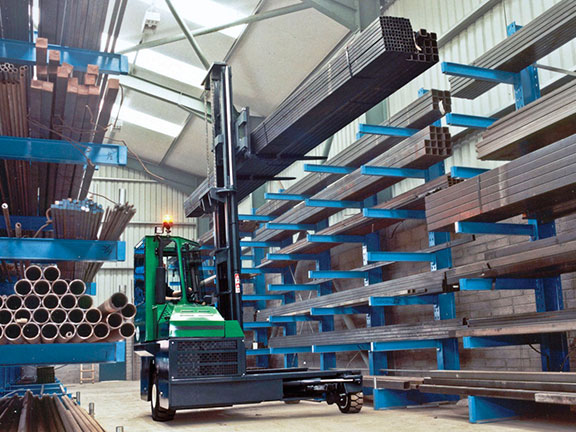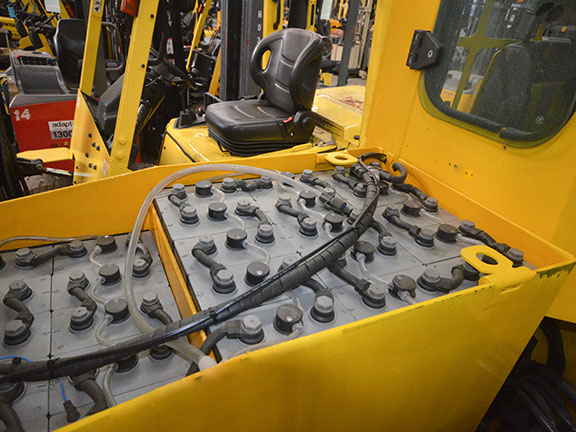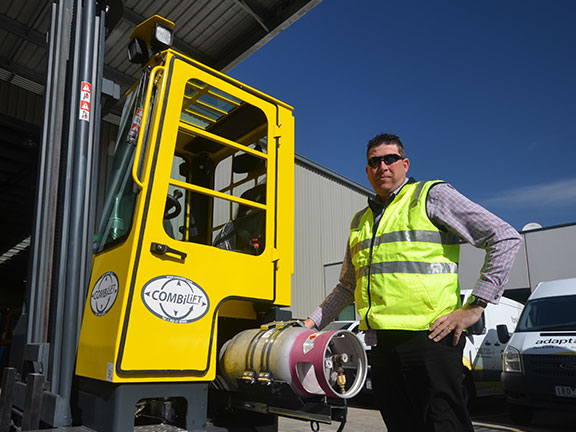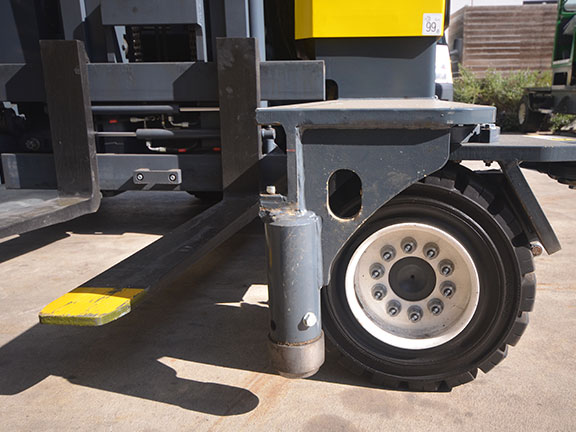With the Combilift C4000 multidirectional forklift, Combilift plugs market leads with innovative solutions.
SINCE its beginning in 1998, Irish company Combilift has been churning out innovative and indispensable materials handling vehicles that get into places you wouldn’t expect – like the Combilift C4000 multidirectional forklift.
The logistical handling of long loads has always presented headaches, especially when it comes to extracting the freight from racking and manoeuvring it around a warehouse or a yard and onto a truck. You ended up with something akin to trying to taxi an A380 down a supermarket aisle. The problem was solved once it was recognised that the trick was to turn a wide load into a long load – which is exactly what the Combilift C4000 forklift does.
Sideways is the new forward
The Combilift C-range of multidirectional forklifts is designed to eliminate the need for different forklifts. Starting at 2.5-tonne capacity and going all the way up to 25 tonnes, the original was the C4000, and it’s the one I’ll be test driving.
The main difference between the Combilift C-series and the more recognisable CB series is the addition of a platform on which to rest your load. The CB is more compact and functions essentially as a multi-directional, standard forklift.
But what do you lose when you gain versatility? The answer – I was slightly surprised to learn – is not much. At first glance, the Combilift C4000 multidirectional forklift looks big and not exactly dainty. As with its relative the Aisle-Master, it’s a bit of an ugly duckling. But what it lacks in aesthetics it more than makes up for in productivity.
To get the basics out of the way, you can choose diesel, LPG or battery-electric. Combilift area sales manager Mike Mostert says that battery-electric is forging ahead in terms of sales numbers, something I’m not surprised to hear – it’s going that way across the board. With good reason, too. As the C4000 is designed to spend a lot of its working life inside, the lack of fumes and noise that battery-electric gives is a strong selling point, especially for operators.
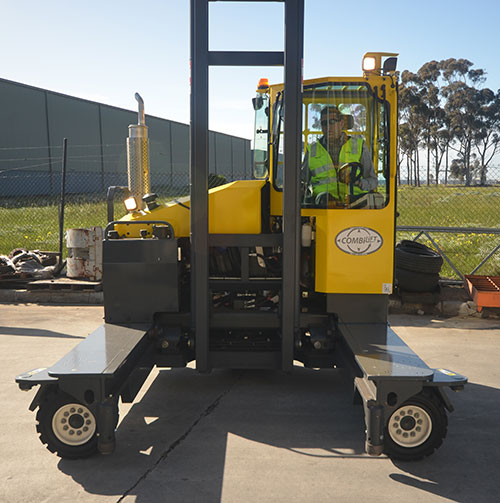 |
|
The Combilift C4000 in east-west travel mode.
|
Looks can be deceiving
I first saw the Combilift C4000 forklift at the recent CeMAT exhibition, and was immediately struck by its size, and the fact its mass is supported by only three wheels. But it’s not really the size that makes you look twice – more the shape.
With a regular counterbalance forklift, you must take into account the space it takes to spin around. But with the Combilift C4000 forklift, spinning around is usually not required, you simply change the direction it moves, meaning it can operate in areas you wouldn’t expect it to be able to. The width is 2190mm and the length 2300mm.
Normally you’ll be crabbing along the aisle sideways, so you’ll need aisles at least 2300mm wide, but not much more than that. If you drop down in capacity to the C3500, the length reduces to 1950mm, making operating in two-metre aisles possible. At a time when cost pressures mean maximising all available space is paramount, every millimetre matters.
Compass points
The Combilift C4000 multidirectional forklift’s main party trick is of course its rotating wheels. You have two modes of travel: north-south and east-west. North-south is what you might call regular forklift mode, with the two smaller front wheels fixed and the much bigger rear doing the turning. Driving in this mode feels natural for anyone familiar with a regular forklift, and the machine responds quickly and smoothly. One handy thing is the cab is offset to the left of the mast, meaning vision is not obstructed when travelling forwards.
To engage east-west mode, you simply flick the joystick lever either left or right. You don’t get an instantaneous change in direction, but rather a whirring rotation of your wheels as they set up for their new configuration. It takes about three seconds. Your big wheel is now fixed east-west (in line with the rear of the machine) and the front wheels doing the turning.
So it’s here where things get a little counter-intuitive, at least at first. For a start, you’re in a bit of a strange situation where you don’t have front and rear wheels, but rather side wheels – one side fixed, one side turning. If you’re having difficulty visualising it right now, don’t worry, it doesn’t take too long to get used to it.
According to Mostert, new Combilift C4000 multidirectional forklift operators become adept at using the machine in five minutes. I would suggest this is slightly ambitious, but it shouldn’t take even the most dyed in the wool traditionalist forkie more than a shift to become confident.
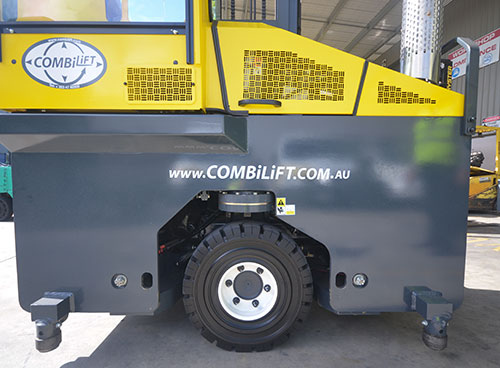 |
|
b2 Front, back or side – the multi-directional Combilift C4000.
|
Nuts and bolts, and ups and downs
The C4000’s tines are contained within the platforms on which the load is designed to rest. In normal, narrow-aisle operation, you would navigate the aisle in east-west mode, extend the tines out beyond the platform, pick your load off the racking, retract in and lower the load onto the platform, maximising stability, before moving out of the aisle. Resting the load on the platform gives a low centre of gravity and eliminates the need to carry long loads high above the racking. A useful optional extra is guided rails in the racking.
The machine locks into the rails and is kept on course as it moves down the aisle, meaning the operator doesn’t have to worry about steering, increasing safety and operator confidence by allowing the operator to focus on load lifting and not steering. By removing margin for error, you’re increasing capacity by allowing every millimetre to be utilised. I like the thinking.
Out in the yard, hydrostatic transmission means acceleration is smooth and ultra-responsive. All three wheels are driven, which is a nice touch too. One surprising thing about this machine is its off-road capabilities. You can throw it around in the mud and all manner of uneven surfaces (it has an IC rating of 46).
There’s no active brake control because of the hydrostatic transmission. What you get instead is an inching pedal, much the same as the left-hand side pedal on a regular forklift. The handbrake is operated by depressing a red button, which for some reason brought to mind an emergency stop button on a rubbish compactor.
A high degree of accuracy can be achieved when approaching and picking up a load, and the load lift is stable throughout the lift height. Be careful not to accidently move the toggle to east-west mode if your front wheels are hard up against anything, as they kick out when rotating, increasing the overall width of the forklift and potentially causing damage to unsuspecting racking.
Under the hood, the internal combustion C4000 is powered by a three-litre General Motors engine. First service comes after 100 hours, then every 250 hours after that. The battery electric model runs the same hydraulic system – you’re just replacing the combustion engine with a battery. I like the simplicity that Combilift adheres to, right down to the fact that the controls inside the cab are instantly recognisable throughout its range.
 |
|
The controls are simple and unique to all Combilift machines.
|
All aboard the carousel
Getting used to the expansive range of movements afforded by the C4000 is both daunting and exhilarating. Mike Mostert instructs me to do something bewildering, to demonstrate how the machine can dance. I turn the steering wheel a few rotations until a red light comes on, indicating ‘carousel’ mode.
“Now, don’t touch the steering wheel, just hit the juice,” says Mostert. It’s counter-intuitive, but I do as he says. The two front tyres are faced in at 45 degrees. The C4000 proceeds to turn within itself, the turning circle so tight that I can’t even explain how it does it. Mostert stays standing right beside my cab, along the left-hand side of the machine.
I’m sure I’ll hit him as I spin round (imagine the paperwork!) but he knows his product better than I do, and he lives to have me tell the tale. This particular Irish jig is quite remarkable, but it doesn’t surprise me. You get used to surprises with the C4000, and they’re nearly always pleasant.
Mostert likens understanding the range of movements that the C400 offers to going from flying a Cessna to a jet. I reckon his analogy is on the right track, but I’d compare it to going from a fixed-wing aircraft to a helicopter, with the added range of gyroscopic movements you need to get your head round.
The bottom line
What Combilift excels at doing is identifying a need in the market and plugging it with innovative and simple solutions. The C4000 opens possibilities for any operator involved in handling and transporting long loads. By keeping the design simple it can be customised to any customer’s requirements.
It’s a machine that can easily become a workhorse, due to its versatility and adaptability. In fact, one of the joys of getting this machine would be experimenting with its range of uses. But to distil it to the bare bones it’s a machine to enable you to get long loads out of a standard door. Sometimes what we do sounds unglamorous when you put it like that, but hey, somebody’s got to do it. And Combilift does it very well.


